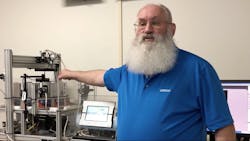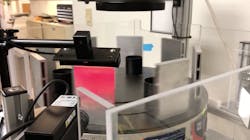At PACK EXPO Connects, Omron Automation showcased what it refers to as Traceability 4.0. Brian Jeppesen, automation engineering supervisor at Omron Automation’s Technology Center, explained that traceability essentially consists of four steps:
- Mark—placing the serial number or lot number information on the product;
- Verify—confirming the mark is made correctly, will be readable, and complies with government regulations;
- Read—a vision system can read the mark to ensure proper routing and shipment; and
- Communicate—sending the mark’s information to a local database or cloud resource.
“The vision system triggers the camera and the strobe light and the camera passes the image back to the vision system,” he explained. “The FH-5050 processes the image and decodes the 2D code. The code value is sent back to the NX102, which sends the decoded data to the cloud using the MQTT protocol. And all of these processes can be programmed and monitored using the Omron’s Sysmac Studio software.”
Jeppesen’s point with the demo was to show how all these technologies combine to illustrate how product and process data can be used to improved quality and production efficiency.
A typical application for a system like this is unit level traceability, which can be very useful in high-volume, high-mix production environments with multiple lines and physical locations. In such production environments, Jeppesen said use of a cloud-based system for analysis and record keeping has advantages over a local data archive.
He explained that the NX102 controller creates a direct connection between the system and the cloud or any other database, eliminating the need for middleware or PCs.
The ability to quickly access and analyze this kind of granular production data is critical to industries such as the food and beverage packaging industry so that contaminated products can be traced to a specific serial number or a lot number. With this level of detail, it means that “all products with a specific part number need not be discarded, only the products with that specific lot number or serial number range would need to be discarded,” Jeppesen said.



